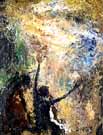
|
|
|

|

|

|

|
|
Click on an image to see a larger, more detailed picture.
|
|
|
|
|
| 1943: Death and Resistance |

|
pg. 426 |

|
|
|
|
| |
 The American-born artist Gideon captured the horrors of war and the Nazi atrocities through the medium of art. His use of color, texture, and haunting images convey the pain and suffering of those caught up in the Nazi whirlwind. The tragic faces of the almost monochromatic art piece juxtaposed with the linked chain and barbed wire evoke the prison motif associated with Nazism.
The American-born artist Gideon captured the horrors of war and the Nazi atrocities through the medium of art. His use of color, texture, and haunting images convey the pain and suffering of those caught up in the Nazi whirlwind. The tragic faces of the almost monochromatic art piece juxtaposed with the linked chain and barbed wire evoke the prison motif associated with Nazism.
Photo: Gideon
|
 The vibrant colors of this piece, also by Gideon, suggest the intense heat of the inferno that was Auschwitz.
The vibrant colors of this piece, also by Gideon, suggest the intense heat of the inferno that was Auschwitz.
Photo: Gideon
|
|

|

|

|

|
 February 10, 1943: A cable devised by several U.S. State Department officials is sent to the U.S. legation in Bern, Switzerland. The cable suggests that the American consul in Bern should no longer transmit information about Jewish atrocities "to private persons in the United States." The cable is sent by Breckinridge Long, Ray Atherton, James Dunn, Elbridge Durbrow, and John Hickerson. Secretary of the Treasury Henry Morgenthau's staff will later describe the cable of February 10 as "the most vicious document we have ever read," designed "by diabolical men" and intended to suppress information on the "Final Solution." "We don't shoot [Jews]. We let other people shoot them, and let them starve." Secretary Morgenthau observes that "when you get through with it, the [State Department's] attitude to date is no different from Hitler's attitude." Secretary Morgenthau's assistant, Randolph Paul, describes the State Department officials involved in America's refugee policy as an "underground movement...to let the Jews be killed."
February 10, 1943: A cable devised by several U.S. State Department officials is sent to the U.S. legation in Bern, Switzerland. The cable suggests that the American consul in Bern should no longer transmit information about Jewish atrocities "to private persons in the United States." The cable is sent by Breckinridge Long, Ray Atherton, James Dunn, Elbridge Durbrow, and John Hickerson. Secretary of the Treasury Henry Morgenthau's staff will later describe the cable of February 10 as "the most vicious document we have ever read," designed "by diabolical men" and intended to suppress information on the "Final Solution." "We don't shoot [Jews]. We let other people shoot them, and let them starve." Secretary Morgenthau observes that "when you get through with it, the [State Department's] attitude to date is no different from Hitler's attitude." Secretary Morgenthau's assistant, Randolph Paul, describes the State Department officials involved in America's refugee policy as an "underground movement...to let the Jews be killed."
|
|
|
|
|
| 1943: Death and Resistance |

|
pg. 426 |

|
|
The Holocaust Chronicle
© 2009 Publications International, Ltd.
|
|
